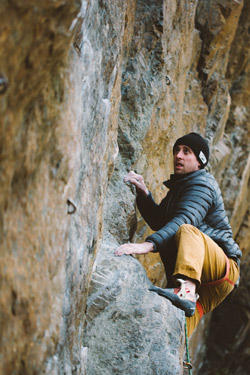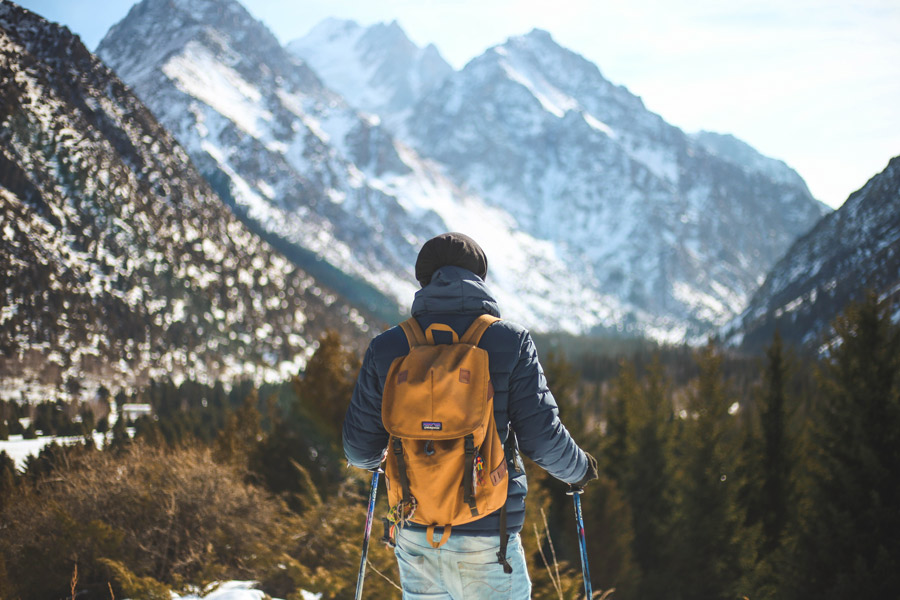



The insulated jacket—AKA the “puffy”— is often the outdoor enthusiast’s most precious article of clothing. It’s a shield against the elements, useful across all seasons: in the thick of winter, the insulated jacket is a primary source of warmth under a ski shell. In spring and fall, the puffy comes on and off to help maintain core temperatures as weather fluctuates. Even in summer, it’s the ultimate insurance policy, stuffed in a backpack during a hike, just in case there’s a storm or, heaven forbid, an injury that forces an unplanned overnight in the woods.

Whether you’re a skier or a snowboarder, a hiker or a backpacker, a climber or a kayaker, insulated jackets fall in the “essential” category. Travelers, too, rely on the lightweight warmth of an insulated jacket; even when jet-setting to temperate climates, a lightweight puffy combats rogue weather and unrelenting airplane air conditioners alike. Not to mention, they’re ideal for everyday life, too—wearing a puffy to work, the gym, or the bar is always a smart option when the mercury drops.
The two main benefits of relying on a puffy:

Versatility:
The puffy is incredibly versatile, and comes in handy across a variety of outdoor pursuits. Part of the puffy’s magic is that it can be utilized in layering systems to handle variable weather conditions: most commonly, the puffy is worn over a breathable base layer and beneath a waterproof shell for a three-layer sandwich that helps wick sweat, maintain core temps, and repel water.
That said, they can also be used on their own, or even thrown over a shell during a quick break to stay warm on an otherwise exerting climb. When employed intelligently, a puffy helps avoid two dangerous extremes: freezing and sweating.
Warmth:
Human beings may have lucked out in the evolutionary lottery—scoring opposable thumbs and occasionally impressive brains—yet we were spared a proper insulating layer. Even the hairiest of humans fail to retain warmth like blubber-, fur-, or down-reliant animals. Puffies act as that insulating layer—like the whale’s thick fat or the duck’s down, the puffy serves to create and retain heat by trapping pockets of warm air.
A few things to consider when choosing a puffy:
As you check out the collection of our favorite insulated jackets below, you’ll realize that not all puffies are built by the same blueprint. They vary in warmth, weight, waterproofing, and features—read on to determine what elements are most important to you.
Down:
Most puffies use some sort of down for insulation, but more and more companies are experimenting with alternative materials these days, be they synthetic or otherwise. Icebreaker’s MerinoLOFT, for instance, relies on sheep’s wool, while PrimaLoft is famous for their use of ultra-thin synthetics. Most exciting as of late: Patagonia’s innovative new PlumaFill—a synthetic insulation material that earned the Micro Puff hoody top honors from our test team.
Waterproofing:
Down: Down is not naturally waterproof, and it actually looses its loft and becomes useless when wet. The down of the duck, for instance, is shielded by a waterproof layer of feathers. Waterproof shells serve this purpose for humans, but insulated jackets can get soaked from both perspiration and precipitation in the field. That said, many outdoor companies treat their down with water-resistant chemicals to ensure that the puffy is still useful in wet conditions.
Fabric: Down isn’t the only cause for concern in the waterproofing department: fabric material needs to be considered as well. Some insulated jackets are crafted from water-repellant external fabrics and are more attuned to be worn solo, while others are made from lighter, less waterproof materials and are designed to be used in a layering system. If you often wear your puffy as an outer layer in wet weather, consider leaning towards a more water-resistant outer layer.

Fill Power:
Down is rated by “fill power,” a number that generally falls between 500 and 900 for quality outdoor equipment. This number refers to a scientific measurement of loft calculated by compressing an ounce of down in a cylinder. All you really need to know is that the higher the number, the higher the quality of the down. And of course, the higher quality down, the higher the price.
Weight:
A jacket can boast high quality down, but still be less help than a wet rag in a rainstorm—that’s because warmth also depends on the weight of the down that’s being used. Basically, the quality of down doesn’t matter unless the quantity is sufficient to keep you warm.
Features:
Puffies—especially when compared to ski jackets and rain shells—are generally devoid of features. While a ski jacket might have more pockets than a pita factory and a multitude of technical fabrics and gizmos, puffies tend to be more austere. Again, this is due to the fact that, more often than not, puffies are used in combination with a shell jacket.
That said, there are three key features to consider when purchasing a puffy: pockets, hood, and fabric.
Over the past few months, we’ve had the opportunity to test ten puffies from top outdoor brands. The following five puffies represent our favorites, with each puffy broken down into a category.
Best Lightweight Puffy: Patagonia Micro Puff
We’ve been loving this Patagonia puffy from the skin tracks of Colorado to the crags of California. Our tester has been relying on it heavily throughout a road trip from Canada to Mexico. If we were to pick a single puffy to recommend across all pursuits, this Patagonia piece is our overall top choice.
The weight of the Micro Puff is cloud-like and nearly negligible. The featherweight puffy is hardly noticeable in your pack or even across your shoulders, however, zip up the quilted jacket and you’re instantly aware of the lofty warmth of Patagonia’s synthetic PlumaFill insulation. PlumaFill is built to mimic down’s basic composition, except where natural down clusters break apart, PlumaFill is a continuous, almost cotton-candy-like synthetic material. An ingenious step forward that’s been the talk of the industry in 2018, PlumaFill’s a packable, lightweight synthetic option that’s still warm when damp and even gives dry down a run for its money.
Our testers loved the baffle structure and cut of the Micro Puff, especially the snug, under-the-helmet hood. The Pertex Quantum fabric was a delight to the most tactile of our testers—it was even comfortable and warm when used after surf sessions against bare, wet skin. Finished with a DWR treatment, the 100% nylon fabric performed well in wet conditions, too.
The 10-denier fabric is not the most durable, and we’ve had a couple rips throughout our testing. However, that’s nothing that Patagonia won’t happily fix if a piece of duct tape won’t do the trick. The main point we’d make in the cons category is that the Micro Puff is not a heavyweight puffy: while it’s warm when used correctly (say, with a wool base layer and a waterproof outer shell), it’s not a standalone puffy during moderate activity in colder weather.
The insulation itself. Patagonia’s new PlumaFill recipe earned five stars from our team.
“I’m in love with this no frills puffy. I wear it everywhere—snowboarding and splitboarding, international travel, cold-weather surf trips. It’s a new favorite for me, and I love how light it is and how small it packs. I can’t recommend it enough.”
Best For: Cold-weather pursuits when used in a layering system, shoulder season activities when used alone.
This Big Agnes Shovelhead has been a literal life-saver to our testers. It’s one of the warmest puffies we’ve tested in the mid-weight category. It has a Goldilocks element to it: it’s warm enough for snowstorms, light enough to be crammed in a backpack, and has a “just right” heft to it. When testing insulators during cold nights on the Canadian coastline and frigid missions into Colorado’s high alpine, there was no puffy we’d rather rely on than this Big Agnes.
Despite being relatively lightweight, the warmth of this puffy is nothing short of radical. The Shovelhead has a proper, cozy thickness to it—thanks to the water-repellant 700 DownTek down and the robust vertical baffles—that makes you feel like you just slipped into a sleeping bag the moment you put it on. No surprise there, as Big Agnes makes some of our favorite sleeping bags on the market. The nylon is tough, durable, and difficult to tear. Zippers are no-nonsense and easy to manipulate, even with only partially functioning, fumbling fingers (been there, zipped that). The thumbholes are a welcome touch on the sleeves, as are the internal mesh stash pockets.
Our favorite element of the Big Agnes is how warm and cozy it is, but that comes at a premium, and the jacket definitely takes up more space when stuffed into a pack, especially when compared to our favorite lightweight puffy, the Patagonia Micro Puff.
Where to start? The Big Agnes puffy was one of the most feature-rich insulated jackets of the entire test, and rather than being overwhelmed by unnecessary bells and whistles, our testers were appreciative of the design elements. Our two favorite features? The thumb holes on the cuffs that keep the sleeves from bunching up while on the move, and the handy chest pocket which moonlights as a stuff sack.
“Many hoods fall off your head when it’s windy or when you have another hood or a helmet on underneath—not this Big Agnes. That said, I can also wear it with no hat or helmet and cinch it down and be perfectly comfortable. This was by far my favorite mid-weight puffy of the test. For those who get cold easily, this is your best bet!”
Best For: Mid-winter missions, skiing and snowboarding, backcountry travel, people who get unbearably cold quite easily.

Testers agreed that the EverTherm was the most comfortable down jacket that we tested this year. Against the skin, the quilt-free fabric is a dream. The revolution of the EverTherm, however, comes in the Thindown technology, which uses diaphanous down sheets as opposed to traditional down baffles to spread warmth evenly across the entirety of the jacket. Indeed, our testers confirmed that cold spots were few and far between.
This is the least puffy puffy in this buyer’s guide. The previous sentence is not a typo—the jacket just doesn’t have that much loft to it. For outdoor lovers who don’t vibe with the bulky, baffled build of the traditional puffy, Eddie Bauer’s designed a welcome alternative. Testers found the StormRepel Duper DWR-treated nylon fabric beat back water well, as it shed light rain without compromising warmth.
The EverTherm isn’t as warm as some of the thicker, baffled puffies in this buyer’s guide, and while there weren’t “cold spots,” testers found themselves craving heartier, heavier down in winter conditions.
Favorite Feature:
The inner lining of the fabric—it’s unreal against the skin. Testers also loved the style of a non-baffled puffy jacket, as it somehow seems a little more formal than your average puffy jacket and consequently more suitable for wearing to a 9-to-5.
“I appreciated the style and innovation of this piece. I’d love to see Eddie Bauer continue pushing to see how much warmer they could take the tech.”
Best For: Everyday use, in the woods and in the city.

Moisture is the mortal enemy of the puffy, as both rain and sweat can cause down to lose its loft. Black Diamond’s gracefully tackled moisture management problems with their First Light Hybrid Hoody. PrimaLoft Silver Insulation Active wraps the chest, arms, and hood with synthetic insulation, while panels of breathable wool along the back and under the arms enable the First Light to shed sweat. Essentially, the PrimaLoft insulation is still effective when wet and the wool panels wick inevitable perspiration. Not only that, but the jacket’s NanoSphere material does a swell job of repelling dew and drizzle. All told, we tested the First Light from Canada to California, dealing with sweat-inducing desert days and foggy, storm-soaked rainforests. For perspiration-prone people and pursuits, this is our top choice.
The First Light Hybrid Hoody is undeniably breathable, and the revolutionary panel design is definitely its most appealing aspect. That said, the wind and water-resistant outer fabric feels like a softshell and outperforms many other puffies in this buyer’s guide when worn sans a rain jacket, too. The elastic cuffs on the arms are a top-notch feature, and do wonders to keep the First Light from riding up the forearms.
The hood is the most form-fitting of the hoodies tested, and works best under a helmet, making it more attuned to the needs of mountaineers and climbers. Again, this isn’t a con, but rather something to consider—if you prefer to have an over-the-helmet option, you’re better off looking elsewhere. Also, while this breathable design is awesome for high-intensity activities, during moderate exertion, the wool panels can be on the chilly side. Lastly, while there are many benefits to PrimaLoft insulation, the material doesn’t pack quite as well as a high-rated down option.
The breathable panel on the back is unbelievably awesome. Oftentimes, whenever you’re on an adventure that requires a puffy, you’re relying on a backpack as well. And adventurers of all creeds know that sweat often starts at the exasperating nexus of pack and lower back. Big thanks to Black Diamond for offering up a more breathable and intelligently designed option for sweaty adventures!
“I really love wearing this with a backpack—sweat is way less of a concern. Also, it does well in wet weather, and the PrimaLoft insulation doesn’t bunch like you sometimes have with a traditional down jacket.”
Best for: Wet weather, sweaty activities like climbing, mountaineering, and backcountry skiing.

This piece is less at home in the wild and more attuned to the concrete jungle. For those who require a touch of rugged yet suave style on city street safaris, this hoodless option from 5.11 is a sharp play. We’ve tested the Peninsula Insulator Shirt Jacket through fall all across California, from the Sierras to SoCal beaches, and the thickness of the insulation is definitely on the lighter side (it’s a shirt jacket, not a true insulated jacket, after all). Additionally, it’s the only jacket included that fastens via snapping buttons instead of a zipper.
Style is the obvious frontrunner here. The 5.11 piece looks as if its been built off of a traditional collared leather jacket design, only with more technical materials. The dual color pattern only drives that home: the blue jacket we tested has an offset darker navy patch that cloaks the chest, shoulders, and collar. Additionally, that off-color patch is where the pocket magic happens—four velcro chest pockets make the jacket feel like Steve Irwin’s iconic vest. Plus, there are another two zippered hand pockets that are spacious, warm, and secure. It’s not the warmest jacket of the buyer’s guide by far, however, the boxy fit, while stylish, does allow you add layers underneath if need be.
Generally, when we’re buying a puffy, we want something that can be used in multiple scenarios. While this 5.11 might be considered versatile by some, for us, the lack of zipper ensures that it would be left behind on ski days, serious hikes, etc. Also, the jacket is definitely not as warm as the other jackets in this buyer’s guide—in moderately cold weather, you’d want to leave this at home.
The quick-stash velcro pockets across the chest—easy to use and they do offer a “tactical” element to the jacket.
“I wouldn’t necessarily wear this on a backpacking trip, but for rocking it to work or around town, I like it way more than I thought I would. I expected the pockets would be on the extreme side, but they do come in handy more often than not.”
Best For: City-slickin’.